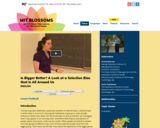
This learning video addresses a particular problem of selection bias, a statistical bias in which there is an error in choosing the individuals or groups to make broader inferences. Rather than delve into this broad topic via formal statistics, we investigate how it may appear in our everyday lives, sometimes distorting our perceptions of people, places and events, unless we are careful. When people are picked at random from two groups of different sizes, most of those selected usually come from the bigger group. That means we will hear more about the experience of the bigger group than that of the smaller one. This isn't always a bad thing, but it isn't always a good thing either. Because big groups ''speak louder,'' we have to be careful when we write mathematical formulas about what happened in the two groups. We think about this issue in this video, with examples that involve theaters, buses, and lemons. The prerequisite for this video lesson is a familiarity with algebra. It will take about one hour to complete, and the only materials needed are a blackboard and chalk.
- Subject:
- Education
- Mathematics
- Social Science
- Sociology
- Material Type:
- Lecture
- Provider:
- MIT
- Provider Set:
- MIT Blossoms
- Author:
- Anna Teytelman
- Arnold Barnett
- MIT BLOSSOMS
- Date Added:
- 06/15/2021